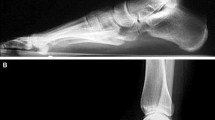Abstract
Purpose
Stage II posterior tibial tendon dysfunction (PTTD) can be treated by flexor digitorum longus (FDL) tendon transfer and medial displacement calcaneal osteotomy (MDCO). Numerous authors have studied the clinical and radiographic results of this procedure. However, little is known about the kinematic changes. Therefore, the purpose of this study was to assess plantar-pressure distribution in these patients.
Methods
Seventy-three patients with PTTD stage II underwent FDL tendon transfer and MDCO. Plantar pressure distribution and American Orthopaedic Foot and Ankle Society (AOFAS) score were assessed 48 months after surgery. Pedobarographic parameters included lateral and medial force index of the gait line, peak pressure (PP), maximum force (MF), contact area (CA), contact time (CT) and force-time integral (FTI).
Results
In the lesser-toe region, PP, MF, CT, FTI and CA were reduced and MF in the forefoot region was increased. These changes were statistically significant. We found statistically significant correlations between AOFAS score and loading parameters of the medial midfoot.
Conclusions
Study results reveal that FDL tendon transfer and MDCO leads to impaired function of the lesser toes during the stance phase. However, there seems to be a compensating increased load in the forefoot region.

Similar content being viewed by others
References
DiPaola M, Raikin SM (2007) Tendon transfers and realignment osteotomies for treatment of stage II posterior tibial tendon dysfunction. Foot Ankle Clin 12:273–285
Roth S, Roth A, Jotanovic Z et al (2013) Navicular index for differentiation of flatfoot from normal foot. Int Orthop 37:1107–1112
Trnka HJ (2004) Dysfunction of the tendon of tibialis posterior. J Bone Joint Surg Br 86:939–946
Yeap JS, Birch R, Singh D (2001) Long-term results of tibialis posterior tendon transfer for drop-foot. Int Orthop 25:114–118
Johnson KA, Strom DE (1989) Tibialis posterior tendon dysfunc- tion. Clin Orthop 239:196–206
Myerson MS (1996) Adult acquired flatfoot deformity. J Bone Joint Surg 78A:780–792
Lechler P, Graf S, Koch FX et al (2012) Arthrodesis of the talonavicular joint using angle-stable mini-plates: a prospective study. Int Orthop 36:2491–2494
Joveniaux P, Harisboure A, Ohl X et al (2010) Long-term results of in situ subtalar arthrodesis. Int Orthop 34:1199–1205
Brodsky JW, Charlick DA, Coleman SC et al (2009) Hindfoot motion following reconstruction for posterior tibial tendon dysfunction. Foot Ankle Int 30:613–618
Marks RM, Long JT, Ness ME et al (2009) Surgical reconstruction of posterior tibial tendon dysfunction: prospective comparison of flexor digitorum longus substitution combined with lateral column lengthening or medial displacement calcaneal osteotomy. Gait Posture 29:17–22
Putti AB, Arnold GP, Cochrane LA et al (2008) Normal pressure values and repeatability of the Emed ST4 system. Gait Posture 27:501–505
Jansen H, Fenwick A, Droht S et al (2013) Clinical outcome and changes in gait pattern after pilon fractures. Int Orthop 37:51–58
Sinclair MF, Bosch K, Rosenbaum D et al (2009) Pedobarographic analysis following Ponseti treatment for congenital clubfoot. Clin Orthop Relat Res 467:1223–1230
Schuh R, Salzberger F, Wanivenhaus AH et al (2013) Kinematic changes in patients with double arthrodesis of the hindfoot for realignment of planovalgus deformity. J Orthop Res 31:517–524
Metaxiotis D, Accles W, Pappas A et al (2000) Dynamic pedobarography (DPB) in operative management of cavovarus foot deformity. Foot Ankle Int 21:935–947
Orlin MN, McPoil TG (2000) Plantar pressure assessment. Phys Ther 80:399–409
Schuh R, Hofstaetter JG, Hofstaetter SG et al (2011) Plantar pressure distribution after tibiotalar arthrodesis. Clin Biomech (Bristol, Avon) 26:620–625
Wainright WB, Spritzer CE, Lee JY et al (2012) The effect of modified Brostrom-Gould repair for lateral ankle instability on in vivo tibiotalar kinematics. Am J Sports Med 40:2099–2104
Wu WL, Su FC, Cheng YM, Huang PJ et al (2000) Gait analysis after ankle arthrodesis. Gait Posture 11:54–61
Kitaoka HB, Alexander IJ, Adelaar RS et al (1994) Clinical rating systems for the ankle-hindfoot, midfoot, hallux, and lesser toes. Foot Ankle Int 15:349–5320
Hillstrom HJ, Song J, Kraszewski AP et al (2013) Foot type biomechanics part 1: Structure and function of the asymptomatic foot. Gait Posture 37:445–451
Mootanah R, Song J, Lenhoff MW et al (2013) Foot Type Biomechanics Part 2: Are structure and anthropometrics related to function? Gait Posture 37:452–456
Hughes J, Clark P, Klenerman L (1990) The importance of the toes in walking. J Bone Joint Surg Br 72:245–251
Rammelt S, Grass R, Zawadski T et al (2004) Foot function after subtalar distraction bone-block arthrodesis. J Bone Joint Surg Br 86-B:659–668
Deland JT (2001) The adult acquired flatfoot and spring ligament complex. Pathology and implications for treatment. Foot Ankle Clin 6:129–135
Guyton GP, Jeng C, Krieger LE et al (2001) Flexor digitorum longus transfer and medial displacement calcaneal osteotomy for posterior tibial tendon dysfunction: a middle-term clinical follow-up. Foot Ankle Int 22:627–632
Myerson MS, Badekas A, Schon LC (2004) Treatment of stage II posterior tibial tendon deficiency with flexor digitorum longus tendon transfer and calcaneal osteotomy. Foot Ankle Int 25:445–450
Myerson MS, Corrigan J, Thompson F et al (1995) Tendon transfer combined with calcaneal osteotomy for treatment of posterior tibial tendon insufficiency: a radiological investigation. Foot Ankle Int 16:712–718
Niki H, Hirano T, Okada H et al (2012) Outcome of medial displacement calcaneal osteotomy for correction of adult-acquired flatfoot. Foot Ankle Int 33:940–946
Wacker JT, Hennessy MS, Saxby TS (2002) Calcaneal osteotomy and transfer of the tendon of flexor digitorum longus for stage-II dysfunction of tibialis posterior. Three- to five-year results. J Bone Joint Surg Br 84:54–58
Author information
Authors and Affiliations
Corresponding author
Rights and permissions
About this article
Cite this article
Schuh, R., Gruber, F., Wanivenhaus, A. et al. Flexor digitorum longus transfer and medial displacement calcaneal osteotomy for the treatment of stage II posterior tibial tendon dysfunction: kinematic and functional results of fifty one feet. International Orthopaedics (SICOT) 37, 1815–1820 (2013). https://doi.org/10.1007/s00264-013-2071-6
Received:
Accepted:
Published:
Issue Date:
DOI: https://doi.org/10.1007/s00264-013-2071-6




